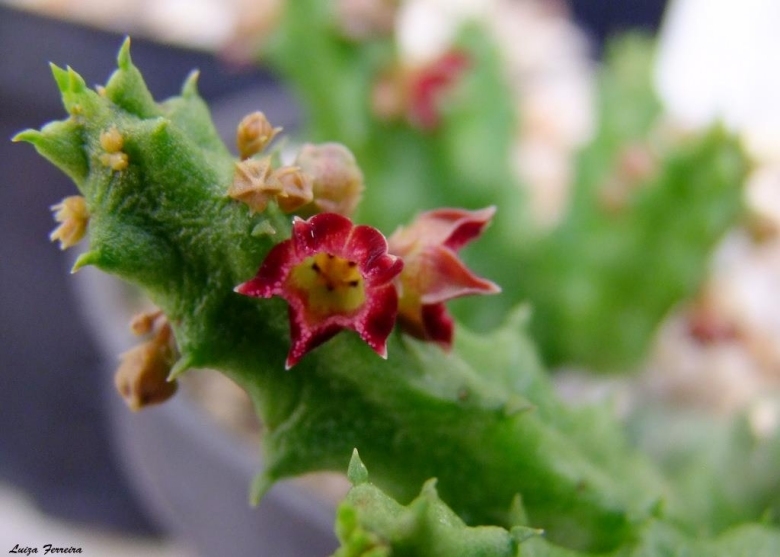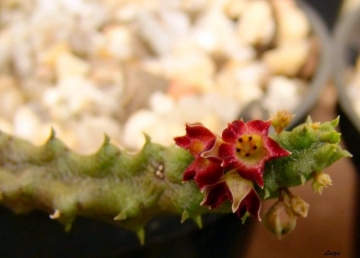




Your support is critical to our success.

Origin and Habitat: Baynesia lophophoraSN|30527]]SN|30527]] is endemic to the mountainous area in the northwestern-most corner of Namibia. It is known from only one location with fewer than 1,000 individuals (extent of occurrence < 625 km²). Type locality: Namibia. Kaokoveld, Baynes Mtns. near the Cunene River.
Altitude range: It occurs at an altitude of 1500-1600 above sea level.
Habitat and ecology: This species grows on very shallow soils in the dry, rocky, transitional fringe between the north-facing cliffs and the relatively flat summit of mountains, with the plants usually well concealed inside tufts of grass. The surroundings vegetation consists mainly of succulents such as Aloe corallina, Cotyledon orbiculataSN|492]]SN|492]], Euphorbia otjipembana, Sarcostemma viminaleSN|27584]]SN|27584]], Adenium obesumSN|116]]SN|116]], Crassula tabularis, and Stapelia schinziiSN|29668]]SN|29668]] var. angolensis. Although this species would be attractive to collectors, the population is fairly inaccessible therefore collecting is not a serious threat at present.
Synonyms:
- Baynesia lophophora Bruyns
Description: Baynesia lophophora is the unique member of the monospecific genus Baynesia. Plants of baynesia are mostly small, consisting of a cluster of soft erect, greenish stems. The tiny nodding, purple flowers are borne in small clusters around the tips of the stems on new growth, and seemingly without any odour. The generic position of this new species is questionable. The finely wrinkled surface of the stems is particularly unusual and is unlike anything else known in southern Africa. The nearest relatives of this monotypic stapeliad genus are probably Caralluma peschii and Pectinaria.
Habit: It is a low-growing spineless clump-forming succulent 30-80(-150) mm diameter.
Stems: Erect, not rhizomatous, fleshy and fairly soft, glabrous, somewhat transversally rugulose and covered with fine papillae, 30-80 mm long, 6-12 mm thick, green to suffused with brown. Tubercles conical, laterally flattened, slightly spreading, fused into 4 obtuse ribs along stem with concave area between them.
Leaves: Rudimentary spreading, soon falling, 1-1.5 mm long, cordate, flattened-conical with very occasional stipular denticles.
Inflorescence: Sessile, glabrous, bracteolate, usually 3-10 per stem, and develop near stem tips, each bearing 1-3(-5) flowers developing in gradual succession.
Flowers: Small, five-pointed mostly nodding and facing partly downward. Pedicel 1.5-2.5 mm long. Sepals lanceolate, pointed, ca. 1.5 mm long, 0.5 mm wide. Corolla campanulate, 3-4 mm long, 6-8 mm in diameter; outside greenish flushed with red; inside deep maroon changing to cream at the base of tube. Tube bowl-shaped, 1.5 mm deep 3-4 mm in diametr. Corolla-lobes erect around tube mouth, triangular 2 mm long and wide, folded back along midrib so that inside crested toward apex and without fringy cilia. This crest is somewhat emphasized by the strongly recurved apices of the lobes. Corona particularly small and very slightly raised above the base (ca. 1 mm tall, 2 mm wide). Outer corona-lobes, transparent to maroon, basally fused to form a shallow bowl, triangular, acute, 0.5 mm long and broad, ascending, fusing with the wing-like extended base of the inner corona. Inner lobes adpressed to backs of the rectangular anthers and mostly equaling them, 0.5 mm long, with obtuse swollen dorsal projection between outer lobes, cream but slightly more intense than the cream of the tube. Pollinia yellow, ellipsoid, aprox. 0.17 x 0.3 mm.
Fruits (follicles): Narrowly fusiform, 25-35 mm long, 2.5-3.5 mm thik, glabrous, smooth, faintly streaked with brown on cream-green.
Seeds: 5 mm long, 1.5-2.0 mm wide, uniformly pale brown.
Bibliography: Major references and further lectures
1) P. V. Bruyns “Baynesia, a New Genus of Stapeliad from the Northwestern-most Corner of Namibia (Apocynaceae)” Novon Bolus Herbarium, University of Cape Town, 7701, South Africa 10(4): 354-358. 2000.
2) Focke Albers, Ulrich Meve “Illustrated Handbook of Succulent Plants: Asclepiadaceae: Asclepiadaceae” Volume 4 Springer Science & Business Media, 2002
3) Craven, P. 2004. Baynesia lophophora. The IUCN Red List of Threatened Species. Version 2014.3. <www.iucnredlist.org>. Downloaded on 14 February 2015.

Baynesia lophophora Photo by: Luiza Ferreira
The gallery now contains thousands of pictures, however it is possible to do even more. We are, of course, seeking photos of species not yet shown in the gallery but not only that, we are also looking for better pictures than those already present. Read More...
Cultivation and Propagation: Baynesia lophophoraSN|30527]]SN|30527]] is new in cultivation but not particularly difficult to grow.
Spring: When winter ends and they begin to grow again, they will require much water and soaking the pots will no longer put the plants at risk for rot. In the spring they will grow well in partial shade and leaving them out in the rain may provide them with the water they need.
Summer: In the summer months they will tolerate heavy rain, but will be just as happy if the season is dry. It's best to sort out the stems while the plants are resting in the summer before they begin their autumnal growth cycle. They will tolerate very hot weather outdoors as long as they are kept in filtered light and this will encourage them to flower in the Autumn. They also enjoy some fertiliser. Moving the plants as they are developing buds may cause them to spontaneously abort the flowers all together.
Autumn: In the fall keep them outdoors until the night time temperatures drop below the 10°C.
Winter: Winter care presents no problems at 10° C with plenty of light. As soon as they are flowered be sure to take extra precautions to keep them dry, because damp cool conditions when the plants are resting is an invitation to fungal infections, but - according to temperatures –some occasional lit watering may be useful.
Potting medium: Since roots are quite shallow, use a cactus mix or add extra perlite or pumice to regular soil potting soil. A gritty, very free-draining compost is suitable, and clay pots help the plants to dry out between watering. Re-pot every 2 years.
Pest and diseases: Baynesias are generally fairly easy to grow, especially if kept pest-free. They are very susceptible to stem and root mealy bugs, and damage from these may well initiate fungal attack. Any time when there is a dead or dying stem in the pot it is important to remove it immediately and completely before other healthy stems can become ill too, isolate the healthy parts, dry them off, and re-root them in new compost.
Propagation: Easiest with stem cuttings. Allow cuttings to dry a day before planting. Stems must be laid (Not buried) on gritty compost and will then root from the underside of the stems. It can also be increased from seeds sowing in spring in moist, sandy peat moss. Barely cover seeds. Seeds germinate quickly.
In any season it's best to lay the stems out for several days before replanting them and then pot them only in dry soil and withhold any water until they begin to shrivel or start growing again.
| Your Actions | |
|---|---|
| Back to Baynesia index | |
| Back to Asclepiadaceae index | |
 |
Back to Succulents Encyclopedia index |
Privacy stantement - Terms and conditions - How to cite - About us - Feedback - Donate



